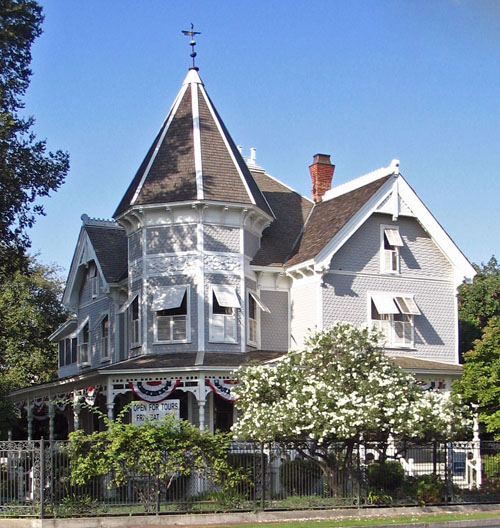
Thomas R. Meux Home (1889)
1007 R Street
Queen Anne
Description
The Meux Home, located at R and Tulare Streets in downtown Fresno, is built in the typical asymmetrical plan common to Victorian residences of the nineteenth and early twentieth centuries. It reflects, in a subdued manner, the eclectic stylistic gamut of that age. The exterior of the house uses towers, Corinthian cornices, corbels, scrolls, fans, string courses and stained or cut glass. The elaborate chimney details above the roof suggest a French Renaissance influence. The high wood-shingled roofs, ridge details, the tower surmounted with an elaborate finial, and finials at the intersection of roof hips of the main roofs give it a touch of Victorian Gothic. The exterior of the house consists of contrasting textures, with staggered shingles at the gable ends, patterned shingles at the second floor level and beveled shiplap siding at the first floor level, finished off at the bottom with a wood detailed water table. Each type of siding is separated from the other by a horizontal wood divider string board. Corner boards capped at top with elaborate corbels provide transition in the direction of wall shingles at wall ends.
The porch extends around the three principal elevations of the house and helps keep the interior relatively cool during the hot summer days. Porch details at railing and stairs are made from simple rectangular wood members intermixed with cut out details of arches and circles. Posts are stock mill-made units.
The interior of the Meux Home is typically Victorian. No part of a wall or ceiling is left undecorated. This was accomplished by papering all walls and ceilings. A picture mold is used in all rooms to separate the ceiling paper from the wall finish.
All millwork and details are stock mill-made units. The doors, however, are of special three-panel design. Stair railings, newell posts and balusters are stock Victorian mill units in a modified classical style. All wood trim is finished with stain and varnish. All fireplaces and mantel decorations are stock units. Tile work around fireplace openings and hearths is of stock art tile. All lighting fixtures are excellent examples of the gas light units prevelant during the latter part of the nineteenth and early twentieth centuries. A stable with a storage room attached is located on the site. The stable included stalls for horses and space to store the phaetons, surreys and a one-horse buggy.
Historical significance
The Meux Home was built in 1889 by Dr. Thomas Richard Meux. Dr. Meux was born in 1838 in Wesley, Tennessee. He attended the University of Virginia and graduated from the University of Pennsylvania Medical School in 1860. During the Civil War he enlisted in 1861 as a private in the Ninth Tennessee Volunteer Regiment of the Confederate Army. He participated in the battles of Shiloh, Murfreesboro and Atlanta. After four years he left the service as an assistant surgeon with the rank of Captain.
In 1874 Dr. Meux married Mary Esther Davis in Brownsville, Tennessee. Mrs. Meux was in poor health and on the advice of a brother who had moved to San Francisco, Dr. Meux decided to move the Central Valley. The family arrived in Fresno in 1887. Dr. Meux chose the corner of Tulare and R streets as the family's homesite in March of 1888.
Meux established his medical practice in 1889 and served as a physician from his office and home the rest of his life. He served as president of the Fresno County Medical Society and was a member of the Fresno County Democratic Club. He and his brother owned vineyards in the county and maintained an interest in agricultural affairs.
The Meux Home was continuously occupied by the Meux family for eighty years. Dr. Meux died at the age of ninety-one in 1929. His daughter, Anne Prenetta Meux, remained in the house until her death in 1970. The home was later acquired by the city of Fresno and is presently open to the public as the Meux Home Museum.
Adapted from the National Register of Historic Places nomination, originally prepared by James J. Nargis.